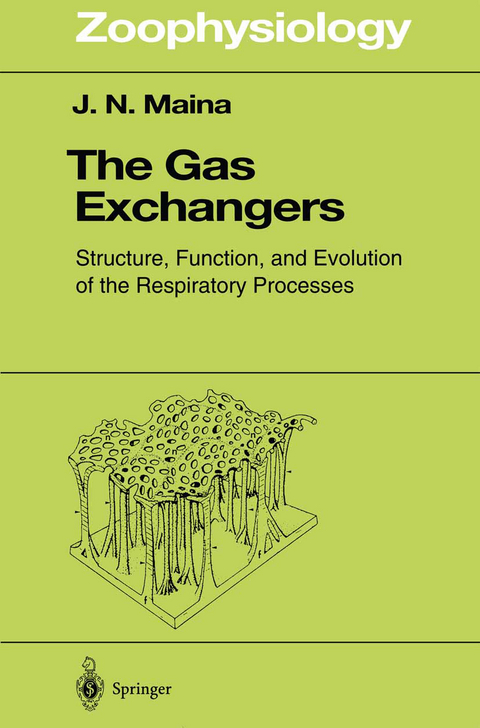
The Gas Exchangers
Springer Berlin (Verlag)
978-3-642-63756-8 (ISBN)
1 Perspectives on Life and Respiration: How, When, and Wherefore.- 1.1 Life: Diversity, Complexity, and Uniformity Fabricated on Simplicity.- 1.2 The Earth: a Highly Dynamic Planet.- 1.3 Factors that Encouraged the Evolution of Life on Earth.- 1.4 Oxygen: a Vital Molecular Resource for Life.- 1.5 Anaerobic Metabolism and Adaptive Success in Animals.- 1.6 Evolved Mechanisms and Strategies of Procuring Molecular O2.- 1.7 Explicating the Process of Evolution of Respiration: Limitations.- 1.8 Plans and Performance Measures of the Gas Exchangers.- 1.9 The Early Anoxic Earth and the Evolution of Life.- 1.10 Abundance of Molecular O2 in the Earth's Biosphere.- 1.11 Shift from Anaerobiotic to Aerobiotic State in the Early Earth.- 1.12 Accretion of Molecular O2.- 1.13 CO2 Pulses in the Biosphere.- 1.14 The Overt and Covert Roles of O2 in Colonization and Extinctions of Biota.- 1.15 Oxygen: a Paradoxical Molecule.- 1.16 The Rise of the Level of Molecular O2: a Curse or a Blessing?.- 1.17 The Evolution of Complex Metabolic Processes.- 1.18 Oxygen and CO2 as Biochemical Factors in Respiration.- 1.19 Homeostasis: the Role of Respiration.- 2 Essence of the Designs of Gas Exchangers - the Imperative Concepts.- 2.1 Innovations and Maximization of Respiratory Efficiency.- 2.2 Safety Factors and Margins of Operation of Gas Exchangers.- 2.3 Engineering Principles in the Design of the Gas Exchangers.- 2.4 Scopes and Limitations in the Design and Refinement of the Gas Exchangers.- 2.5 Optimal Designs in Biology and Gas Exchangers in Particular.- 2.6 Fractal Geometry: a Novel Approach for Discerning Biological Form.- 2.7 From Diffusion, Perfusion, and Ventilation to Respiratory Pigments.- 2.8 Blood and the Respiratory Pigments.- 2.9 Energetic Cost and Efficiency of Respiration.- 2.10Modeling: Utility in Study of Integrative Construction of the Gas Exchangers.- 3 Gas Exchange Media, Respiratory States, and Environments.- 3.1 Water and Air as Respiratory Media: General Considerations.- 3.2 Physical Charateristics of Water and Air.- 3.3 The Distribution of Water and Air on Earth.- 3.4 Water: a Respirable Medium and an Integral Molecule for Life.- 3.5 Terrestrial Habitation and Utilization of Atmospheric O2.- 3.6 Hydrogen Sulfide Habitats. Tolerance and Utilization.- 3.7 The Porosphere and Fossorial Respiration.- 3.8 Living at High Altitude: Coping with Hypoxia and Hypobaria.- 3.9 Gravity: Effects on Respiratory Form and Function.- 4 Water Breathing: the Inaugural Respiratory Process.- 4.1 The Design of the Gills.- 4.2 Adaptive Diversity and Heterogeneity of Gill Form.- 4.3 The Functional Innovations of the Gills for Aquatic Respiration.- 4.4 The Simple Gills.- 4.5 The Complex Gills.- 4.6 The Water Lungs.- 4.7 The Placenta: an Ephemeral Liquid to Liquid Gas Exchanger.- 5 Bimodal Breathing: Compromise Respiration.- 5.1 The Water-Air Interface: an Abstract Respiratory Rubicon.- 5.2 Strategies and Adaptive Convergence for Air Breathing.- 5.3 Risks, Costs, and Benefits in the Change to Air Breathing.- 5.4 CO2 Elimination: Impediment to Evolution of Air Breathing and Terrestriality.- 5.5 Control and Coordination of the Bimodal Gas Exchange Process.- 5.6 Taxa with Notable Propensity for Bimodal Breathing.- 6 Air Breathing: the Elite Respiration.- 6.1 Is the Surface of the Lung Dry, Moist, or Wet? Do Real Air Breathers Exist?.- 6.2 Lung and Swim Bladder - Which Developed Earlier and for What Purpose?.- 6.3 Evolution of Air Breathing and Terrestriality: the Limitations.- 6.4 Aerial Gas Exchangers: Structural and Functional Diversity.- 6.5 The Diffusive Type Gas Exchangers.- 6.6 The Mixed Type Gas Exchangers.- 6.7 The Convective Type Gas Exchangers.- 6.8 The Internal Subdivision of the Lung: the Functional Implications.- 6.9 The Surfactant: a Versatile Surface Lining of the Gas Exchangers.- 6.10 Nonrespiratory Roles of the Gas Exchangers.- 6.11 The Implications of Liquid Breathing in Air Breathers.- 6.12 Physical Gill and the Plastron: a Unique Underwater Respiratory Strategy.- 6.13 The Cleidoic Egg: a Fascinating Gas Exchanger.- 6.14 The Bottom Line.- References.
| Erscheint lt. Verlag | 21.10.2012 |
|---|---|
| Reihe/Serie | Zoophysiology |
| Zusatzinfo | XX, 498 p. |
| Verlagsort | Berlin |
| Sprache | englisch |
| Maße | 155 x 235 mm |
| Gewicht | 784 g |
| Themenwelt | Studium ► 1. Studienabschnitt (Vorklinik) ► Physiologie |
| Naturwissenschaften ► Biologie ► Biochemie | |
| Naturwissenschaften ► Biologie ► Zoologie | |
| Schlagworte | Adaption • Anatomie • anatomy • Anpassung • Atmung • Colon • Evolution • Gasaustausch • gas exchanger • Metabolism • oxygen • respiration • Sauerstoff |
| ISBN-10 | 3-642-63756-6 / 3642637566 |
| ISBN-13 | 978-3-642-63756-8 / 9783642637568 |
| Zustand | Neuware |
| Haben Sie eine Frage zum Produkt? |
aus dem Bereich


